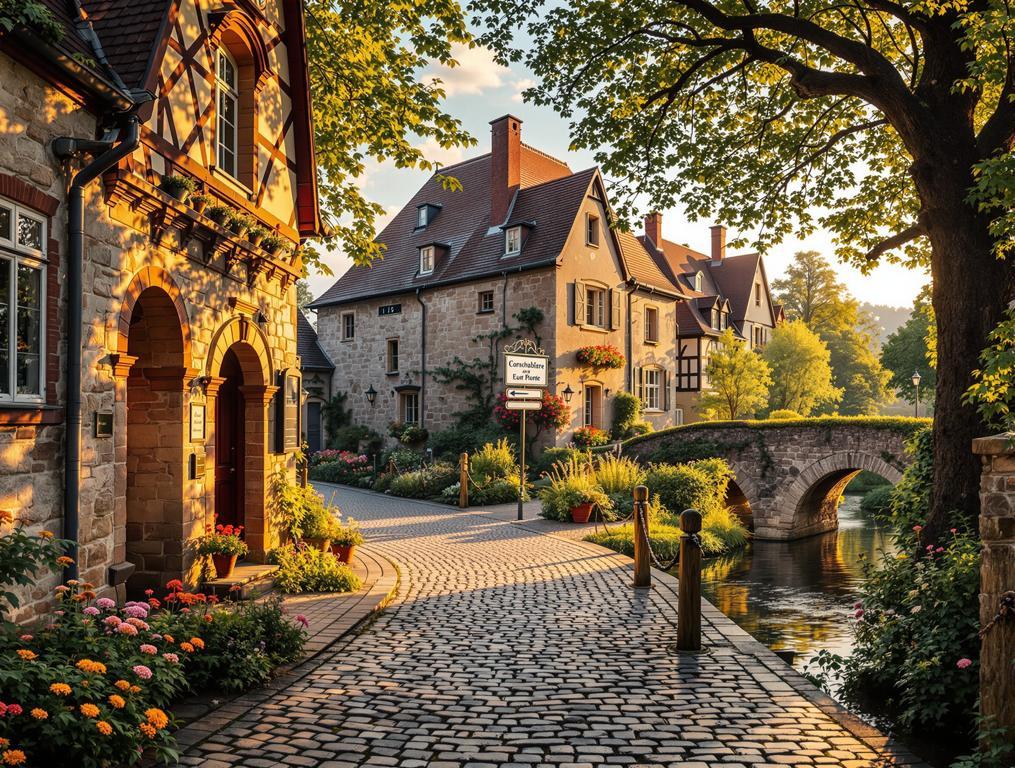I’m standing on a cobblestone street that feels like it was transported straight from a Bavarian valley. The morning sun catches on limestone walls as a rooster crows somewhere in the distance. This is Maeystown, Illinois – just 20 minutes from St. Louis but worlds away from American modernity. With only 147 residents living among 60 preserved German structures, this 0.12-square-mile village offers the highest concentration of authentic 19th-century German architecture I’ve seen in America.
I run my hand along a peculiar stone channel alongside the road. This isn’t just any gutter – it’s part of the 400-foot vertical stone gutter system, the longest in the United States. Built by German immigrants in the 1850s, these limestone pavers have directed rainwater for over 170 years.
America’s 0.12-Square-Mile Bavarian Village Hidden in Illinois
The morning fog lifts to reveal Maeystown’s original stone bridge, which locals fought fiercely to preserve in 1970. This tiny settlement presents a statistical anomaly: one historic German structure for every 2.45 residents. It’s a preservation ratio unmatched in the Midwest.
Walking through the warren-like lanes feels like exploring a Rhine Valley village. Unlike Texas’ authentic German settlement where annual festivals draw thousands, Maeystown remains miraculously untouched by commercial tourism.
The village’s German heritage runs deeper than aesthetics. Church services here were conducted in German until 1943 – nearly a century after most German-American communities had switched to English. This linguistic preservation created a true cultural time capsule.
400-Foot Stone Gutters: Engineering Marvel That Rivals German Originals
The vertical stone gutters – Maeystown’s engineering masterpiece – differ crucially from typical American drainage systems. While America’s longest beach town preserves natural treasures, Maeystown preserves human ingenuity.
Traditional gutters lay stones flat, but Maeystown’s German settlers placed theirs vertically – a technique imported directly from the Rhine Valley. This method prevents erosion by anchoring deeper into the soil, explaining their remarkable longevity.
“You won’t find this anywhere else in America. I’ve traveled through Bavaria extensively, and walking through Maeystown gives me the same feeling – minus the eight-hour flight and jet lag.”
While France’s architectural marvels often draw international attention, Maeystown’s precision stonework remains virtually unknown outside regional circles. This obscurity has become its preservation superpower.
Where Authenticity Survived: A Rhine Valley Without Commercial Tourism
Inside the Maeystown General Store, original 1904 shelving holds locally-made preserves. The building remains remarkably unchanged since Theodore Roosevelt’s presidency. Unlike New England historic village experiences where Colonial architecture dominates, Maeystown offers pure German craftsmanship.
The village’s five businesses operate primarily on weekends. The Sweet Shoppe serves hand-dipped ice cream in a century-old building. Hank & Lilly’s Creekside Bar & Grill offers German-inspired dishes that would make a Munich grandmother nod approvingly.
Most remarkably, Maeystown lacks the commercial trappings that have transformed similar historic villages. There are no tour buses, no souvenir shops selling mass-produced trinkets, no parking meters – just authentic preservation maintained by generations of residents.
The Perfect June 2025 Window: When to Visit America’s German Time Capsule
June represents the sweet spot for experiencing Maeystown. The limestone buildings absorb spring sunshine, wildflowers bloom along creek paths, and the village’s canopy of ancient oaks provides perfect shade for afternoon explorations.
Start at the Mill & Museum (open 10am-4pm weekends), where displays explain the village’s unlikely survival. Then wander the stone bridge and follow the 400-foot gutter system uphill for the best village panorama.
For travelers seeking authentic American experiences this summer, the authentic Chesapeake experience offers similar charm, though with entirely different architectural roots.
As I drive away from Maeystown, I realize I’ve experienced something increasingly rare – a place that hasn’t compromised its soul for tourism dollars. Like finding an unretouched black-and-white photograph in an age of filtered Instagram posts, Maeystown’s authenticity feels both jarring and refreshing. My daughter Emma would call it “old-timey perfect” – and sometimes seven-year-olds understand authenticity better than travel writers with decades of experience.
